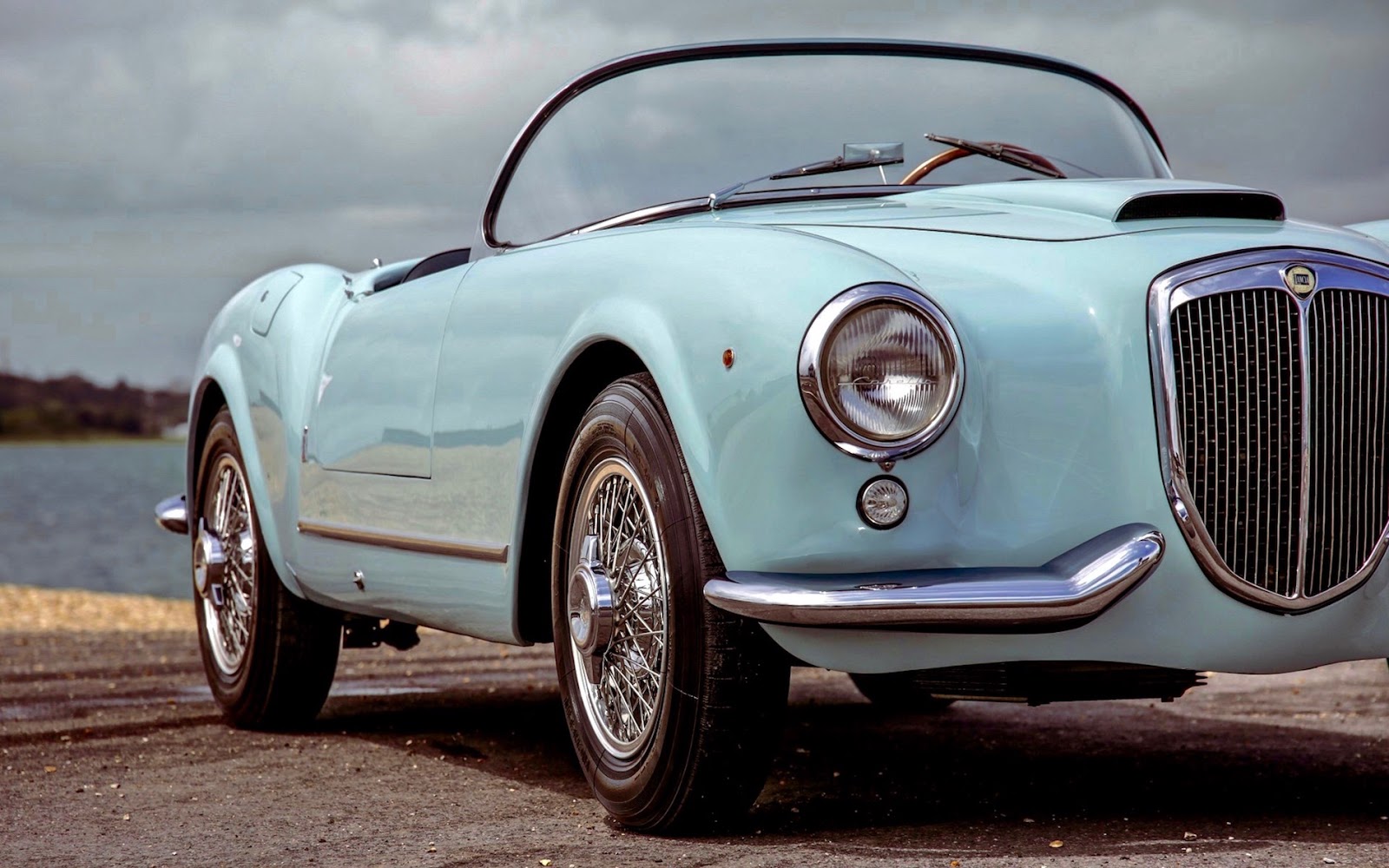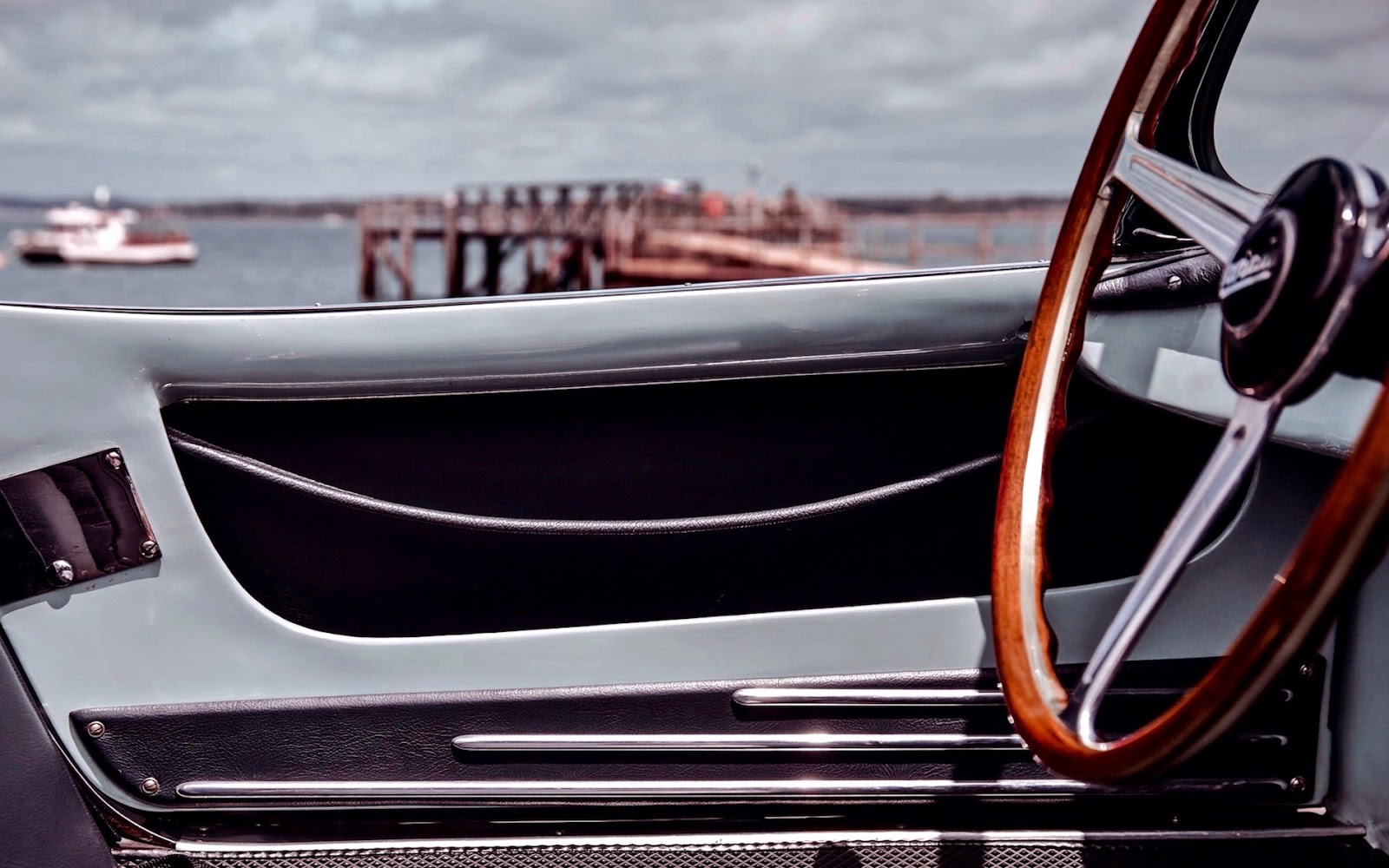1955 Lancia Aurelia B24S Spider Pininfarina
6V 2451,31 cm³, 118 HP @ 5.000 RPM (110 HP US version), overhead valves
Maximum speed180 km/h (174 Km/h US model)
Maximum speed180 km/h (174 Km/h US model)
Summer 1954: the prototype of a splendid spider designed by Pininfarina whizzes taround the streets of Turin. It's the very first Aurelia B24 (chassis no. 0001), right end drive, as it is used for sportcars, even on this side of the Channel. It seems, is driven by Gianni Lancia himself...
The idea of the young Mr. Lancia is an elite product, sporty and with trendy lines also attractive for the overseas public. In a few months, this prototype will be registered and, driven by the pilots Luigi Villoresi and Dorino Serafini, will participate on September 3, 1955 in the Supercortemaggiore Trophy.
The stock production of the legendary B24 starts at the end of December 1954, with only one Spider completed. But at the factory they are working very hard to produce the car to ship to the first 1955 motor show in Brussels. On January 15, 1955 the B24S (the S indicates the left-hand drive) chassis no. 1002, light gray with burgundy interior is on display in Belgium: it keeps the mechanics of the Lancia Aurelia B20, with the engine just modified in some of its components (air filter, fan, water pump) in order to be housed under the hood that is much lower than that of the sedan. The windshield is panoramic, surrounded by a chromed brass profile, very fashionable in the USA (as on the 1953 Corvette spider). The front has the classic Lancia grille, and the passenger compartment is elegantly positioned in the center of the wheelbase (shortened by 20 cm compared to the B20), between an abundant engine hood and a tail almost as long as the hood. The latter is very clean with the lines that harmoniously connect with the swelling of the rear fenders: it contains a large luggage compartment that can be opened from the inside, with spare wheel and battery placed in a special double bottom. The doors have no handles and are opened via a metal tie covered by eco-leather placed inside the door, no side windows (removable Plexiglas panels can be attached to the doors with two wing nuts), the hood is in canvas and rests on a tubular structure that folds into the small space behind the seats, which are sliding and folding. The steering wheel has three aluminum spokes, the dashboard has a curved sporty tone, the instruments are three circular dials positioned astride the steering column. The car on stage in Brussels is equipped with wheel covers with fake spokes: there won't be many cars equipped like that, since normal disc wheels will soon be adopted. The precious Borrani spoke wheels, like for the model featured in this post, will be instead mounted by the owners, few years later. The hard top is not included among the accessories supplied, but they are produced by Pininfarina and the Fontana coachbuilding factory in Padova. The car in this post is infact equipped with a Fontana hard top. The hardtop fits on the main bodywork with three front wing nuts and two rear ones. Since these are handmade components, each hard top correctly pairs only with the car for which it was built.
The car in this post is the B24S chassis no. 1044. It was sold in the United States, probably in 1955, and was originally gray color with burgundy interiors. In fact, the first light blue B24 (color that became the flagship of the B24) was the car number 1148. The current paint scheme is the result of a restoration that took place in Italy in the 90s. The car is now entrusted to Sotheby's for auction sale, with a base price of 1,250,000 USD! In 1955, the B24 could be purchased in USA for about 5,500 USD. But it was an extremely expensive car: a Jaguar XK140 (with a capacity of 3.4 liters) costed 4,500 USD, a Porsche 3,500, a Chevrolet Corvette 3,000. It is estimated that less than 200 B24s were sold out of Italy overall, but only a hundred of the first series, such as n. 1044.
A very rare car!
The last B24 Spider left the factory in October 1955: in total, not counting the prototype, 240 were built (of which only 59 with right-hand drive). Over the next three years, 150 B24 Convertible America and 371 GT Convertible will be produced. These are characterized by some minor mechanical improvements but above all by not having the panoramic windshield, for having different bumpers, a different air intake on the hood, larger doors with handles and descending glasses. The dashboard is also less rounded and with different gauges.
Estate 1954: per le strade di Torino sfreccia il prototipo di una splendida spider disegnata da Pininfarina. E' la prima Aurelia B24 (telaio n. 0001), guida a destra, come si usa per le sportive, anche al di qua della Manica, e, pare, sia guidata da Gianni Lancia in persona…
L'idea del giovane Lancia è quella di un prodotto d'élite, sportivo e con linee alla moda anche per il pubblico d'oltreoceano. Tra qualche mese, questo prototipo sarà immatricolato e, alla guida dei piloti Luigi Villoresi e Dorino Serafini, parteciperà il 3 settembre 1955 al Trofeo Supercortemaggiore.
L'idea del giovane Lancia è quella di un prodotto d'élite, sportivo e con linee alla moda anche per il pubblico d'oltreoceano. Tra qualche mese, questo prototipo sarà immatricolato e, alla guida dei piloti Luigi Villoresi e Dorino Serafini, parteciperà il 3 settembre 1955 al Trofeo Supercortemaggiore.
La produzione in serie della leggendaria B24 inizia alla fine del dicembre 1954, con una sola Spider ultimata. Ma in fabbrica si lavora febbrilmente per produrre l'esemplare per il primo salone dell'automobile del 1955 a Bruxelles. Il 15 gennaio 1955 la B24S (la S indica la guida a sinistra) telaio n. 1002, grigio chiaro con interni rossi è in esposizione in Belgio: adotta la meccanica della Lancia Aurelia B20, con il motore appena modificato in alcune sue componenti (filtro aria, ventilatore, pompa dell'acqua) per poter essere alloggiato sotto al cofano che risulta molto più basso di quello della berlina. Il parabrezza è di tipo panoramico, contornato da un profilato di ottone cromato, molto di moda negli USA (come sulla Corvette spider nel 1953). Il muso ha la calandra classica Lancia, e l’abitacolo è elegantemente posizionato al centro del passo (accorciato di 20 cm rispetto alla B20), tra un cofano motore abbondante e una coda lunga quasi quanto il cofano. Quest’ultima è molto pulita con pinne appena accennate che si raccordano armoniosamente con il rigonfiamento dei parafanghi posteriori: contiene un ampio vano bagagli apribile dall'interno, con ruota di scorta e batteria collocate in un apposito doppiofondo. Le portiere sono prive di maniglie e si aprono tramite un tirante metallico ricoperto da una guaina in similpelle posto all'interno della portiera, niente vetri laterali (esistono pannelli amovibili in plexiglas da agganciare alle portiere tramite due galletti ciascuno), la capote è in tela e appoggia su una struttura tubolare e ripiegabile a scomparsa nel piccolo spazio alle spalle dei sedili, scorrevoli e ribaltabili. Il volante ha tre razze in alluminio, il cruscotto ha un andamento curvo e avvolgente d'intonazione sportiva, la strumentazione è a tre quadranti circolari posti a cavallo del piantone dello sterzo.
L'esemplare esposto a Bruxelles è munito di calotte copriruota con finti raggi: le vetture così equipaggiate non saranno molte, visto che ben presto si adotteranno le normali ruote a disco. Le pregevoli ruote Borrani a raggi tangenti, come quelle del modello che presentiamo in questo post, vengono invece montate per iniziativa dei proprietari, qualche anno dopo.
Il tettuccio rigido (hard-top) non è previsto tra gli accessori forniti dalla casa, ma ne risultano realizzati da Pininfarina e dalla carrozzeria Fontana di Padova. Quest’ultimo è l’hard top di cui è dotata la vettura di questo post. Il fissaggio alla carrozzeria dell'hardtop avviene mediante tre galletti al parabrezza e due posteriori. Trattandosi di componenti artigianali, ciascun hard top si accoppia correttamente solo con l’esemplare per cui è stato realizzato.
L’auto delle immagini è la B24S con telaio n. 1044. Fu venduta negli Stati Uniti, probabilmente nel 1955, e originariamente era di colore grigio con interni bordeaux. Infatti, la prima B24 celeste (tinta che divenne un “classico” della B24) fu quella con il telaio numero 1148. L’attuale livrea è frutto di un restauro che ha avuto luogo in Italia negli anni ’90. L’auto è stata affidata a Sotheby’s per la sua vendita all’asta, con un prezzo base di 1.250.000 dollari! Nel 1955 la B24 negli Stati Uniti si poteva avere per circa 5.500 dollari. Ma era un’auto estremamente costosa: una Jaguar XK140 (con cilindrata di 3,4 litri) costava 4.500 dollari, una Porsche 3.500, una Chevrolet Corvette 3.000. Si stima che meno di 200 B24 furono complessivamente vendute oltreoceano, ma solo un centinaio di spider prima serie come la n. 1044.
L'ultima B24 Spider lascia la fabbrica nell'ottobre del 1955: in totale, non conteggiando il prototipo, ne sono state costruite 240 (di cui soltanto 59 con guida a destra). Nei tre anni seguenti saranno prodotte ancora 150 B24 Convertibile America e 371 Convertibile. Queste si caratterizzano per alcune minori migliorie meccaniche ma soprattutto per non avere il parabrezza panoramico, per paraurti più avvolgenti, una diversa presa d'aria sul cofano, le portiere più ampie hanno le maniglie e vetri discendenti. Anche il cruscotto è meno arrotondato e la strumentazione è diversa.
Main specs: Body type: 2 seater convertible/cabriolet, 2 doors. Wheelbase: 2,450mm (96.5’). Length: 4,230 mm (166.5’). Width: 1,555mm (61.2’). Height: 1,305mm (51.4’). Kerb weight; 1,070 kg (2,359 lb). Engine: 2,451cc (149.569 cu in), V6 overhead valves (OHV), 2 valves per cylinder; maximum power output 120 PS (118 bhp) (88 kW) at 5,000 rpm; maximum torque: 172 Nm (127 ft·lb) (17.5 kgm) at 3500 rpm; compression ratio 8:1.













































No comments:
Post a Comment
Unsigned comments and comments containing links will be removed.
I commenti non firmati e quelli che contengono links saranno rimossi.